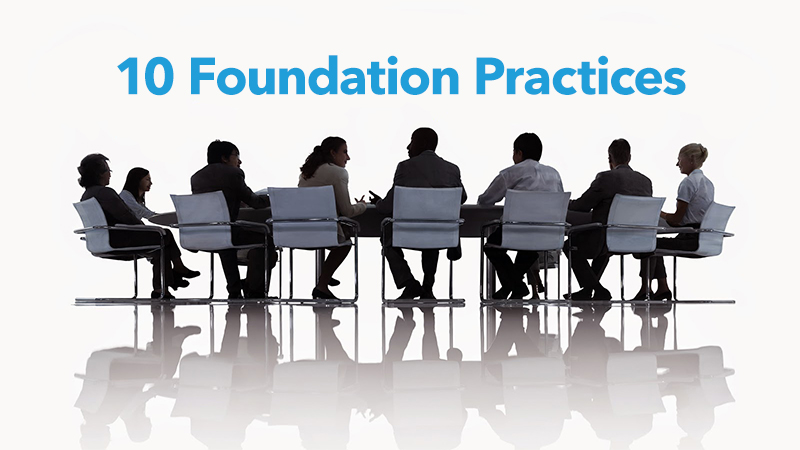10 Foundation Best Practices

1.) Collaborate With Your Friends
Friends groups and Foundations are looking more and more at ways they can collaborate or merge to increase support of the Library and present a more easily understood structure to the community. When members of the general public are confused by more than one group that supports the Library, they may choose not to support either. If both groups are going to coexist, they need to develop communication plans that clearly articulate the role that each group plays while referencing the other group in their messages to their members and donors.
2.) Hire Fundraising Staff
Library Foundations are finding it necessary to hire fundraising staff rather than taking on all of the work with volunteers. In short, it takes money to make money. Fundraising is far more than asking someone to make a contribution. A comprehensive development program includes nurturing donors, providing ways to recognize donors, keeping track of donor activity in a database, and communicating with donors at times other than when asking them to contribute. Volunteers should not be expected to do all of this.
3.) Never Fund Lost Public Funding
Library Foundations should not fund the areas of lost public funding in a library’s operating budget. Foundations should focus their funding on enhancements and innovative programming including things such as the summer reading program, homework help centers, outreach programs, specialized collections, and enhancements to a building project through a capital campaign. Losses to the operational budget should be addressed through a political advocacy effort, which all library foundations should conduct.
4.) Regularly Perform Advocacy Efforts
All Library Foundations should conduct political advocacy activities in support of strong public funding for the Library. If you fundraise for an institution that is predominantly public funded, you should also conduct political advocacy activities to remind the elected officials that your private donors will never fund the general costs of operating a public library. Lobbying is a legal activity for non-profit organizations to conduct as long as they do not endorse a specific candidate for elected office and they do not spend more than 20% of their annual operating budget on lobbying activities. There are a few other prohibitions with which you should become familiar.
5.) Have Profitable Special Events
If you conduct a special event (gala), do it in such a way that you will make a profit. There should be a major emphasis on finding corporate and media sponsors for the event. A media sponsor will not usually give money, but they can provide exposure through in-kind ads that your corporate sponsors will want to see. Corporate sponsorship should account for at least half of your attendees. You will never be profitable by selling 100% of your seats to individuals.
6.) Don’t Limit the Size of Your Board
A Library Foundation’s Board should be large enough to represent all spheres of influence in the community. There is no need to limit the size of the Board in the organization’s by-laws. A fundraising organization’s Board needs to be of a size that will allow the Board to penetrate every part of your community’s donor base. In addition, a large Board may be needed to populate the variety of standing committees which a successful library foundation needs to have.
7.) Make Sure Your Board is Donating
All Foundation Board members should make an annual financial contribution to the organization. Most Foundations do not dictate the size of gift required. One hundred percent participation is more important than the actual amount of a gift. Specifying the size of annual giving may eliminate some Board members from participating on your Board such as former elected officials who may not have personal wealth but who know virtually everyone in the community.
8.) Create a Development Plan
Every Library Foundation needs to have a current development plan to guide all of the organization’s activity. The development plan should be a three year strategic plan to indicate the types of fundraising activities to be undertaken with annual goals and responsibilities delineated.
9.) Create Endowments
The Foundation should attempt to create endowments through a planned giving program. An annual drawdown of ( 4-5% of the endowment value averaged over the previous 12 quarters) should be taken to help support the operations of the Foundation and to support specific library services and programs specified by the endowment. The best way to create and increase endowment funds is through planned giving and by including an endowment component in any capital campaign. All gifts received through planned giving efforts should be placed in an endowment unless the donor specifies otherwise. Most planned givers like the idea of their gift being one which will support the organization in perpetuity.
10.) Foster Inter-Organizational Relationships
Almost all of the problems encountered by Library Foundations can be attributed to relationship problems between Foundation staff and Board and the Library Director, Friends and Trustees. Develop excellent communication vehicles to keep everyone informed of what each group is doing and consider having at least one meeting annually for all Board members of the Foundation, Friends, and Trustees as well as key library staff. In addition, each group (the foundation, the Friends, and the Library Trustees) should have ex-officio, non-voting representation from the other groups to facilitate on-going communication between the groups.

